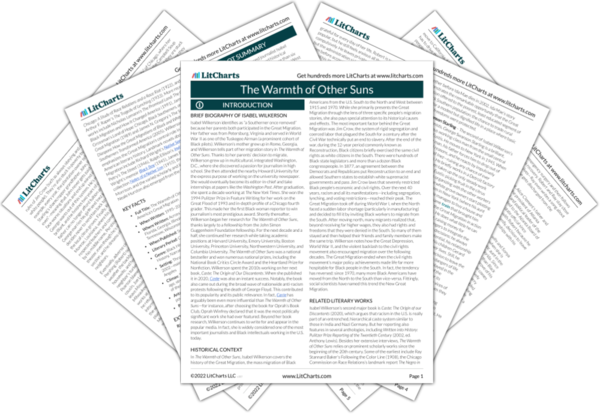Isabel Wilkerson identifies as “a Southerner once removed” because her parents both participated in the Great Migration. Her father was from Petersburg, Virginia and served in World War II as one of the Tuskegee Airman (a prominent cohort of Black pilots). Wilkerson’s mother grew up in Rome, Georgia, and Wilkerson tells part of her migration story in
The Warmth of Other Suns. Thanks to her parents’ decision to migrate, Wilkerson grew up in multicultural, integrated Washington, D.C., where she discovered a passion for journalism in high school. She then attended the nearby Howard University for the express purpose of working on the university newspaper. She would eventually become its editor-in-chief and take internships at papers like the
Washington Post. After graduation, she spent a decade working at
The New York Times. She won the 1994 Pulitzer Prize in Feature Writing for her work on the Great Flood of 1993 and in-depth profile of a Chicago fourth grader. This made her the first Black woman reporter to win journalism’s most prestigious award. Shortly thereafter, Wilkerson began her research for
The Warmth of Other Suns, thanks largely to a fellowship from the John Simon Guggenheim Foundation fellowship. For the next decade and a half, she continued her research while taking academic positions at Harvard University, Emory University, Boston University, Princeton University, Northwestern University, and Columbia University.
The Warmth of Other Suns was a national bestseller and won numerous national prizes, including the National Book Critics Circle Award and the Heartland Prize for Nonfiction. Wilkerson spent the 2010s working on her next book,
Caste: The Origin of Our Discontents. When she published it in 2020,
Caste was also an instant success. Notably, the book also came out during the broad wave of nationwide anti-racism protests following the death of George Floyd. This contributed to its popularity and its public relevance. In fact,
Caste has arguably been even more influential than
The Warmth of Other Suns—for instance, after choosing the book for Oprah’s Book Club, Oprah Winfrey declared that it was the most politically significant work she had ever featured. Beyond her book research, Wilkerson continues to write for and appear in the popular media. In fact, she is widely considered one of the most important journalists and Black intellectuals working in the U.S. today.
